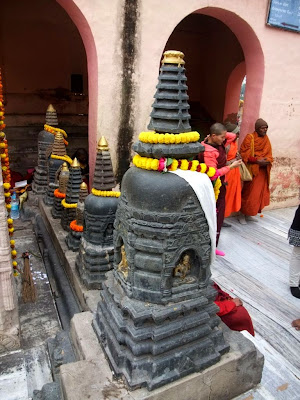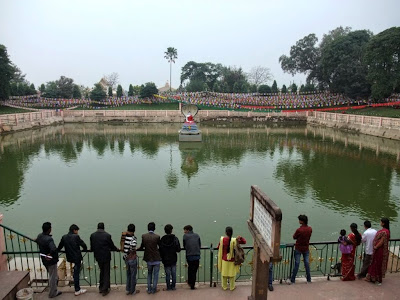
There are significant places associated with incidents immediately followed to Buddha's enlightenment. The Lord spent the succeeding seven weeks meditating at seven different spots in the vicinity. Animeshlochan Chaitya Prayer Hall situated on a raised up area to the north of the central path, was the spot where Lord Buddha spent his 2nd week after enlightenment, standing still gazing uninterrupted at the Bodhi Tree, in appreciation for its shelter during his meditation.



A standing image of unblinking Buddha is enshrined in the Hall of Animeshlochan Chaitya to commemorate the spot where Buddha spent a week gazing at Mahabodhi Tree in gratitude after he attained enlightenment..




Animeshlochana Chaitya is a miniature of Mahabodhi Temple, standing slightly off the walk way towards the main temple. Many Hindu pilgrims frequent the site as they believe and worship Lord Buddha as the 9th incarnation of their God Vishnu. The structures at the lower end is the memorial of Brahma who lived here in 15th-16th century.



The Jewel Promenade or Lotus Walk Cankamana is a raised platform built to the northern side of Mahabodhi Temple marking the place where Buddha paced back and forth in meditation in his 3rd week after enlightenment. He walked 18 steps and it was said that lotus flower sprang out on each step he moved.



The 18 lotus flowers carved on the platform depicts the legend, whereas, the several pieces of incomplete stones lotus placed on the ground next to it, are relics dating from 3rd century, King Asoka built to commemorate the event.



The whole platform that carved with stone lotus marking the 18 steps of Buddha was entirely covered up and decorated with sea of offering flowers, colorful and awesome!.




Courtyard of temple is studded with many smaller Stupas and Buddha images, of which some were several hundred years in history.



The small shrine along the walk way at central path houses a standing image of Buddha and a black stone carved with Buddha's foot prints. The Foot Print Padas dates from 3rd century. King Asoka after declared Buddhism to be the original religion of the State, installed Padas all over his kingdom .


Temple complex is dotted with an abundance of Stupas. Majority dated back to Pala period (8-12th) with few that had older history. Stupas were mostly built by pilgrims who came from Buddhist countries like Myanmar, Sri Lanka and Tibet.




A cluster of votive Stupas built by kings, princes, noblemen, lay people, varied in shape and size, from simplest to most sumptuous ones. Each and every Stupas and images are offered with flowers.



Seated in front of this little shrine of Ratanaghara Chaitye, are one senior and two junior monks, mindfully doing their daily homework, reading texts and meditation. This was the site where Lord Buddha did his meditation in his 4th week after enlightenment. Buddha emitted rays of six dazzling colored lights while in deep meditation here. It was said that design of the current Buddhist flags was based on these colors.



Many ancient monasteries though only left behind some remains and foundations, they were highly respected by Buddhist devotees and pilgrims. Most of the sites are gratefully adorned and honored with offering of flowers, lamps and beautiful decoration.


The site of Mahabodhi Temple Complex and its surroundings went through many changes in 4th to 6th centuries. The remains of sanctuaries, monasteries, shrines, Buddhist images contributed and built by foreign rulers over centuries, documented the evolving worship since the first temple was built in 3rd century by King Asoka.







Lord Buddha spent his 7th week after enlightenment meditating under a Rajyatana Tree, the spot south east of Mahabodhi temple. Two merchants Tapussa and Bhallika came in and offered him rice cake and honey after his meditation. Buddha spent time preaching to them and they took two refuges with Buddha.



Pillar marks the site of Ajapala Nigrodh tree under which Lord Buddha meditated in his 5th week and answer the questions of Brahmas. He told 4 Brahmana that only by ones' deeds one becomes a Brahmana not by birth. It was also the place where Mara sent his three beautiful daughters to tempt Buddha.


Lotus Pond located outside the enclosure of Mahabodhi Temple complex and surrounded by circulating passages is 5 meter below the level of the surrounding land. The pond represents the specific site of Mucalinda Tank to commemorate the meditation spot of Buddha in his 6th week after enlightenment. The actual site of Mucalinda Tank had completely dried up without any water .


In his 6th week after enlightenment, Buddha meditated under a Mucalinda tree, about a mile south of Mahabodhi Temple. It began to rain heavily but he was well sheltered by huge King Copra which was said to be manifested from a Naga King living in a pond near the tree. The copra coiled its body seven times around Lord Buddha to keep him warm and placed his hood over Buddha's head to protect him from the rain. The rain stopped after seven days and the copra changed into a young man and paid his respects to The Lord who in return, delivered to him the following verses:
Happy are they who are contented. Happiness is for those who hear and know the truth.
Happy are they who have good will in this world towards all sentiment beings.
Happy are they who have no attachments and have passed beyond sense-desires.
The disappearance of the word "I AM" is indeed the highest happiness....Sadhux3


No comments:
Post a Comment